An Effective Color Image Encryption Based on Henon Map, Tent Chaotic Map, and Orthogonal Matrices
Abstract
:1. Introduction
2. Mathematical Preliminaries
2.1. Henon Map
- , where is the initial value.
- , where is the control parameters.
- is the secret key of the permutation phase
2.2. Chaotic Tent Map (CTM)
2.3. Orthogonal Matrix
3. Image Encryption and Decryption Algorithms
3.1. Permutation Process
| Algorithm 1. Pixel Permutation |
| Input: Secret key Henon map (1), Color image . Output: Array L of permuted pixels of an image .
|
3.2. Substitution Phase Using Hill Cipher with Orthogonal Matrix
| Algorithm 2. Key Generation of Permutation Process |
| Input: Output:
|
| Algorithm 3. Hill Cipher with Orthogonal Matrix |
| Input: Permuted image array Output: An array of order .
|
3.3. Diffusion Phase
| Algorithm 4. Pixel Diffusion |
| Input:, CTM (3) Output:.
|
3.4. Image Decryption Process
| Algorithm 5. Pixel Decryption Process |
| Input: Cipher image , Secret keys , Henon Map (1), CTM (3). Output: Colored image
|
4. Analytical Results and Performance Evaluation
4.1. Statistical Analysis of Histogram
4.2. Histogram Variance Analysis
4.3. Chi-Square Test Analysis
4.4. Correlation Analysis of Adjacent Pixels
4.5. Mean Square Error Analysis
4.6. Peak Signal to Noise Ratio Analysis
4.7. Sensitivity Analysis
4.8. Information Entropy Analysis
4.9. Key Space Analysis
4.10. Computational Time Analysis
4.11. Key Sensitivity Analysis
4.12. Cryptanalysis
4.12.1. Chosen-Plaintext Attack
4.12.2. Chosen-Ciphertext Attack
5. Conclusions
Author Contributions
Funding
Institutional Review Board Statement
Informed Consent Statement
Data Availability Statement
Acknowledgments
Conflicts of Interest
References
- Mahajan, P.; Sachdeva, A. A Study of Encryption Algorithms AES, DES and RSA for Security. Glob. J. Comput. Sci. Technol. 2013, 13, 15–22. [Google Scholar]
- Mandal, A.K.; Parakash, C.; Tiwari, A. Performance Evaluation of Cryptographic Algorithms: DES and AES. In Proceedings of the IEEE Students’ Conference on Electrical, Electronics and Computer Science, Bhopal, India, 1–2 March 2012; pp. 1–5. [Google Scholar]
- Lorenz, E.N. Atmospheric predictability as revealed by naturally occurring analogues. J. Amos. Sci. 1969, 26, 636–646. [Google Scholar] [CrossRef] [Green Version]
- Bourbakis, N.; Alexopoulos, C. Pictyre data encryption using SCAN patterns. Pattern Recognit. 1992, 25, 567–581. [Google Scholar] [CrossRef]
- Jiri, F. Symmetric ciphers based on two dimensional chaotic maps. Int. J. Bifurcat Chaos 1998, 8, 1259–1284. [Google Scholar]
- Scharinger, J. Fast encryption of image data using chaotic Kolmogorov flow. J. Electron. Eng. 1998, 7, 318–325. [Google Scholar] [CrossRef] [Green Version]
- Yen, J.C.; Guo, J.I. A new image encryption algorithm and its VLSI architecture. In Proceedings of the IEEE Workshop Signal Processing Systems, Taipei, Taiwan, 22 October 1999; pp. 430–437. [Google Scholar]
- Li, S.; Zheng, X.; Mou, X.; Cai, Y. Chaotic encryption scheme for real time digital video. In Proceedings of the SPIE on Electronic Imaging, San Jose, CA, USA, 19 January 2002. [Google Scholar]
- Chen, G.; Mao, Y.; Chui, C.K. A symmetric image encryption based on 3D chaotic maps. Chaos Solitons Fractals 2004, 21, 749–761. [Google Scholar] [CrossRef]
- Fozia, K.; Rehan, S.; Farheen, Q. Hill Cipher Key Generation Algorithm by using Orthogonal Matrix. Int. J. Innov. Sci. Mod. Eng. 2015, 3, 5–7. [Google Scholar]
- Usc-Sipi Image Database for Research in Image Processing, Image Analysis, and Machine Vision. Available online: http://sipi.usc.edu/database/ (accessed on 19 September 2017).
- Patro, K.A.K.; Soni, A.; Netam, P.K.; Acharya, B. Multiple grayscale image encryption using cross-coupled chaotic maps. J. Inf. Secur. Appl. 2020, 52, 102470. [Google Scholar] [CrossRef]
- Patro, K.A.K.; Acharya, B. An efficient dual-layer cross-coupled chaotic map security-based multi-image encryption system. Nonlinear Dyn. 2021, 104, 2759–2805. [Google Scholar] [CrossRef]
- Kanwal, S.; Inam, S.; Cheikhrouhou, O.; Mahnoor, K.; Zaguia, A.; Hamam, H. Analytic study of a novel color Image Encryption Method Based on the chaos System and color codes. Complexity 2021, 2021, 5499538. [Google Scholar] [CrossRef]
- Chen, C.; Sun, K.; Xu, Q. A color image encryption algorithm based on 2D-CIMM chaotic map. China Commun. 2020, 17, 12–20. [Google Scholar] [CrossRef]
- Zhang, L.-M.; Sun, K.-H.; Liu, W.-H.; He, S.-B. A novel color image encryption scheme using the fractional-order hyperchaotic system and DNA sequence operations. Chin. Phys. B 2017, 26, 10. [Google Scholar] [CrossRef]
- Patro, K.A.K.; Acharya, B.; Nath, V. Various dimensional colour image encryption based on non-overlapping block-level diffusion operation. Microsyst. Technol. 2020, 26, 1437–1448. [Google Scholar] [CrossRef]
- Chidambaram, N.; Raj, P.; Thenmozhi, K.; Amirtharajan, R. Advanced framework for highly secure and cloud-based storage of colour images. IET Image Process. 2020, 14, 3143–3153. [Google Scholar] [CrossRef]
- Nkandeu, Y.P.K.; Tiedeu, A. An image encryption algorithm based on substitution technique and chaos mixing. Multimed. Tools Appl. 2019, 78, 10013–10034. [Google Scholar] [CrossRef]

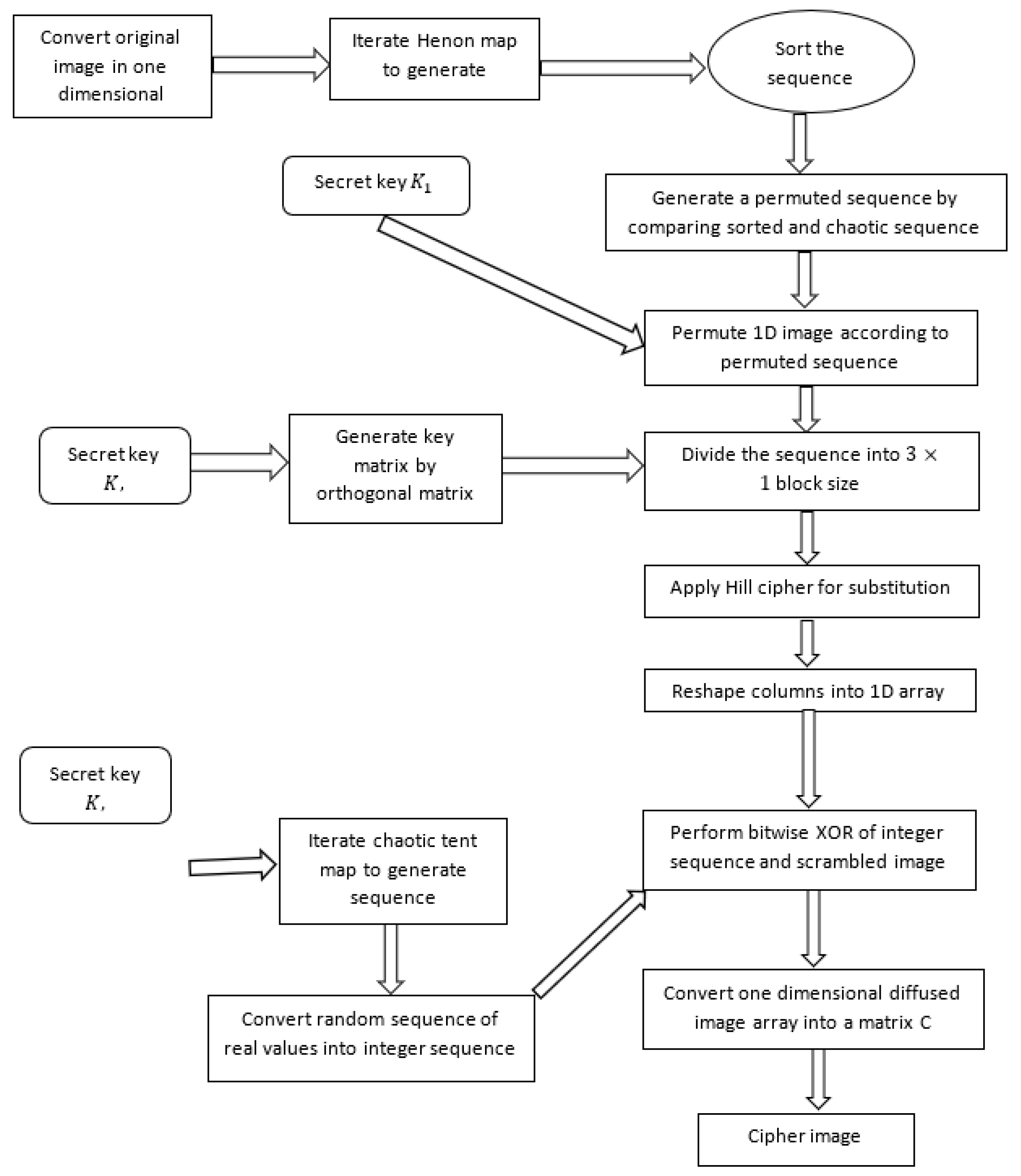
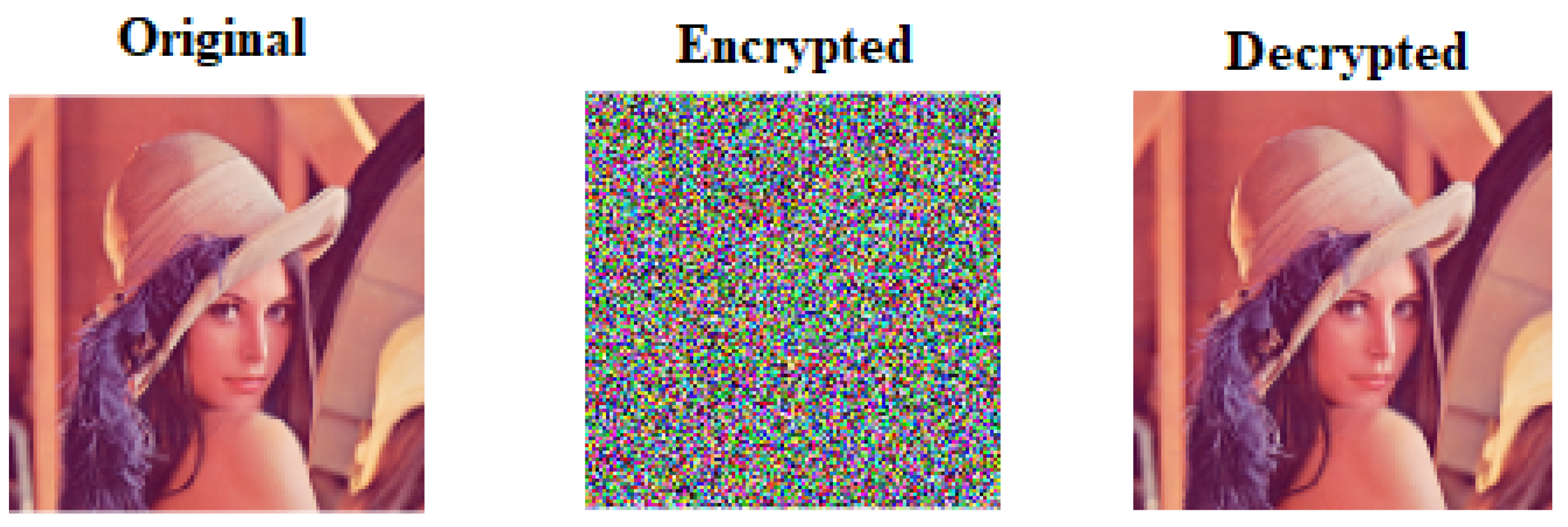
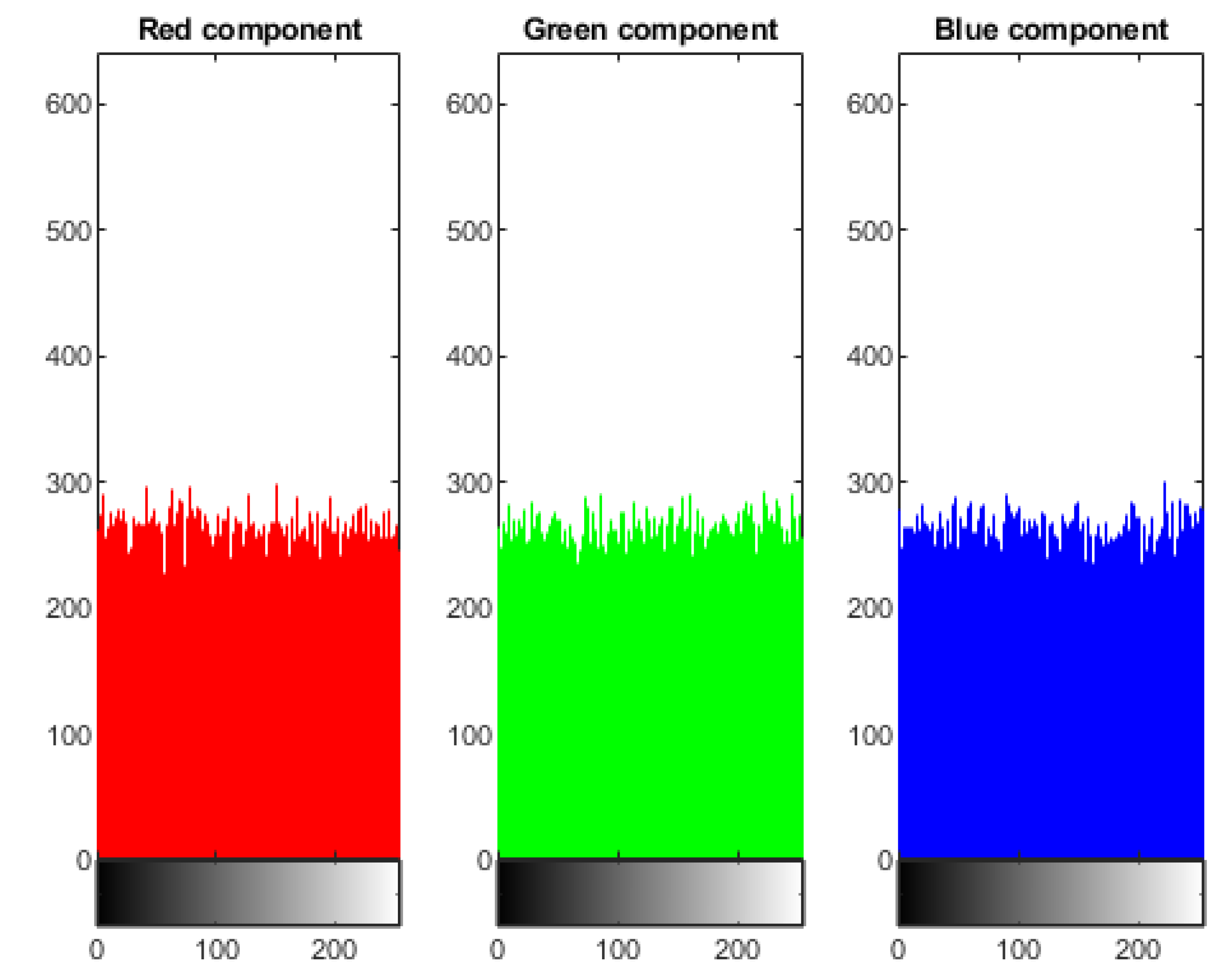
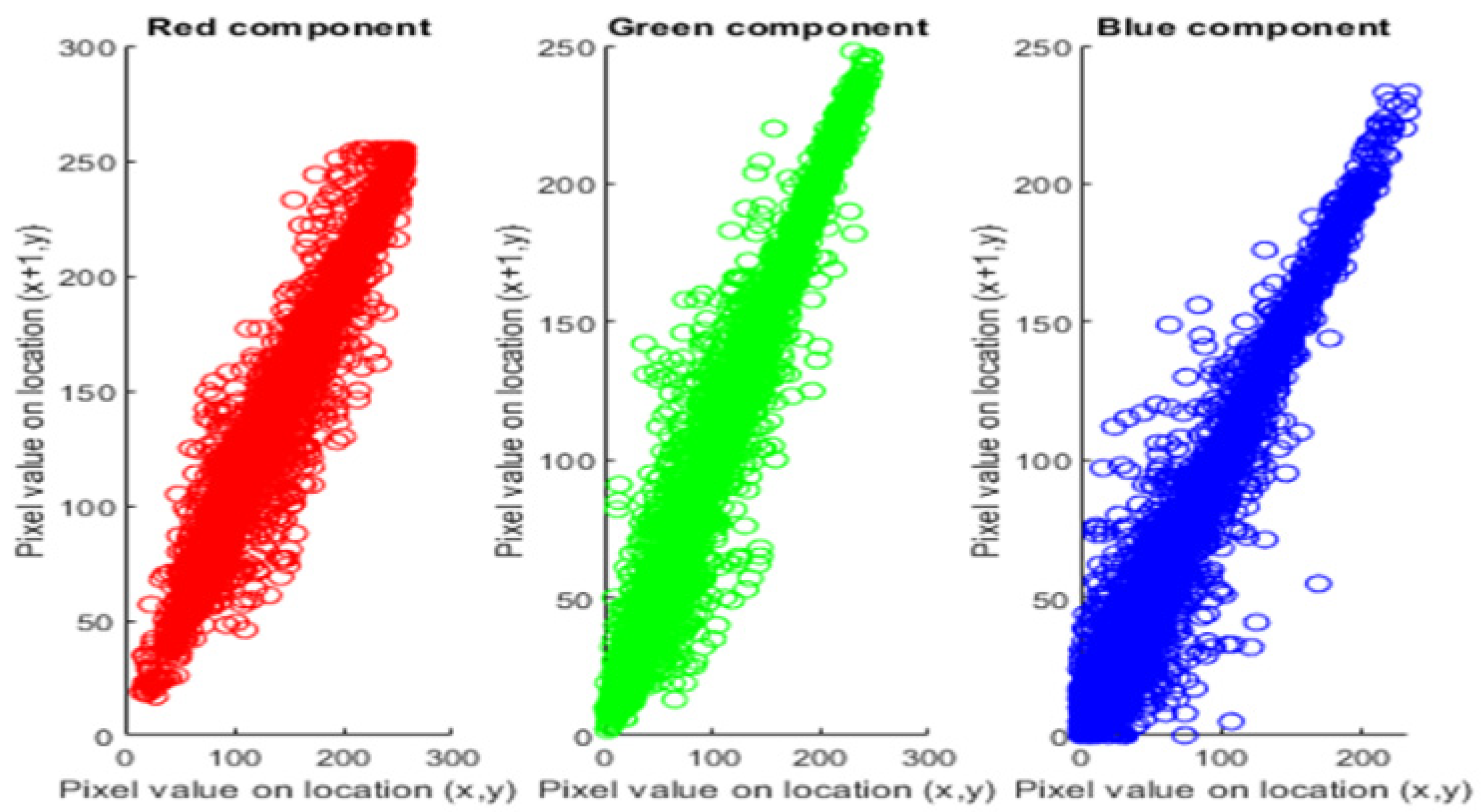
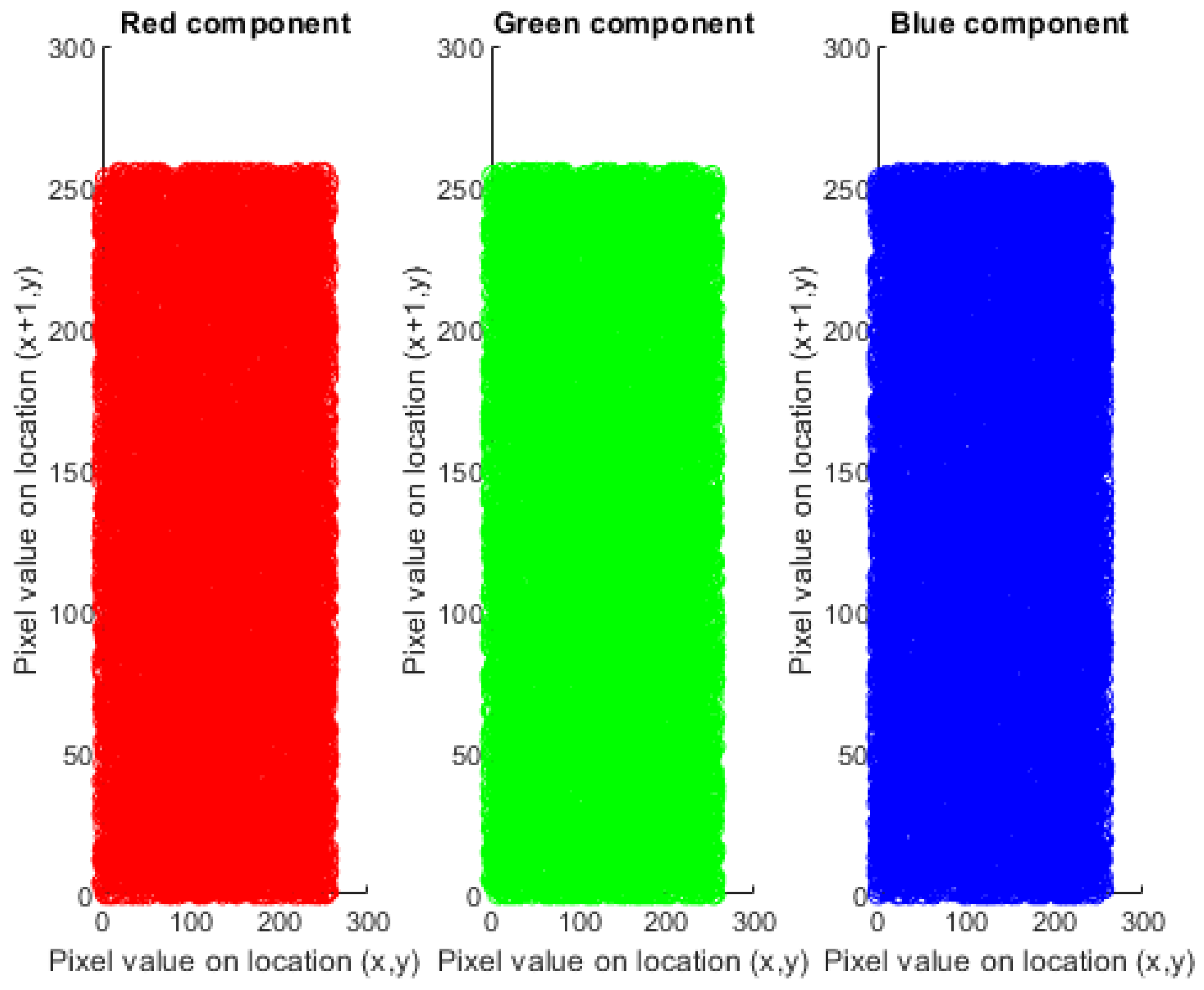

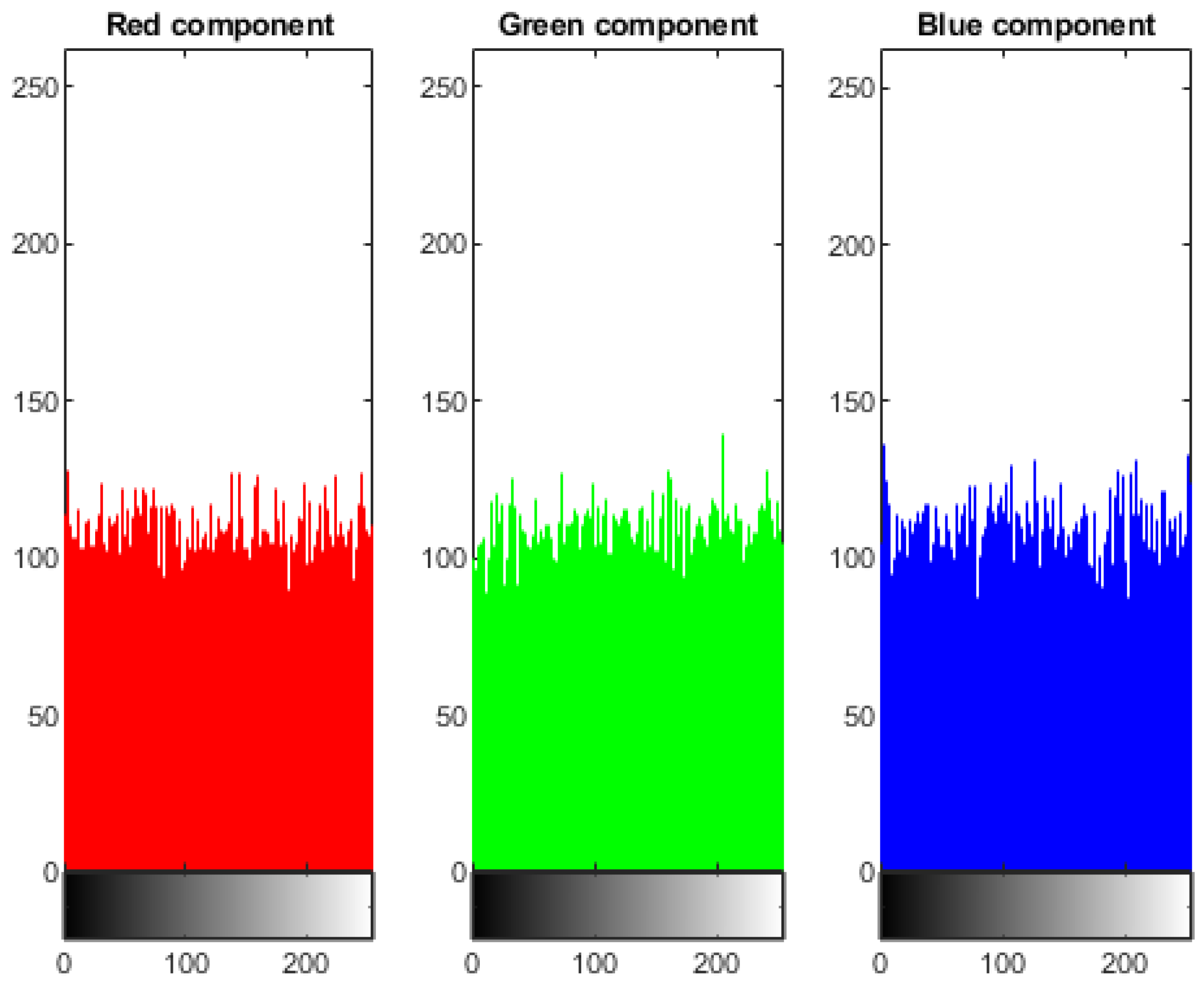
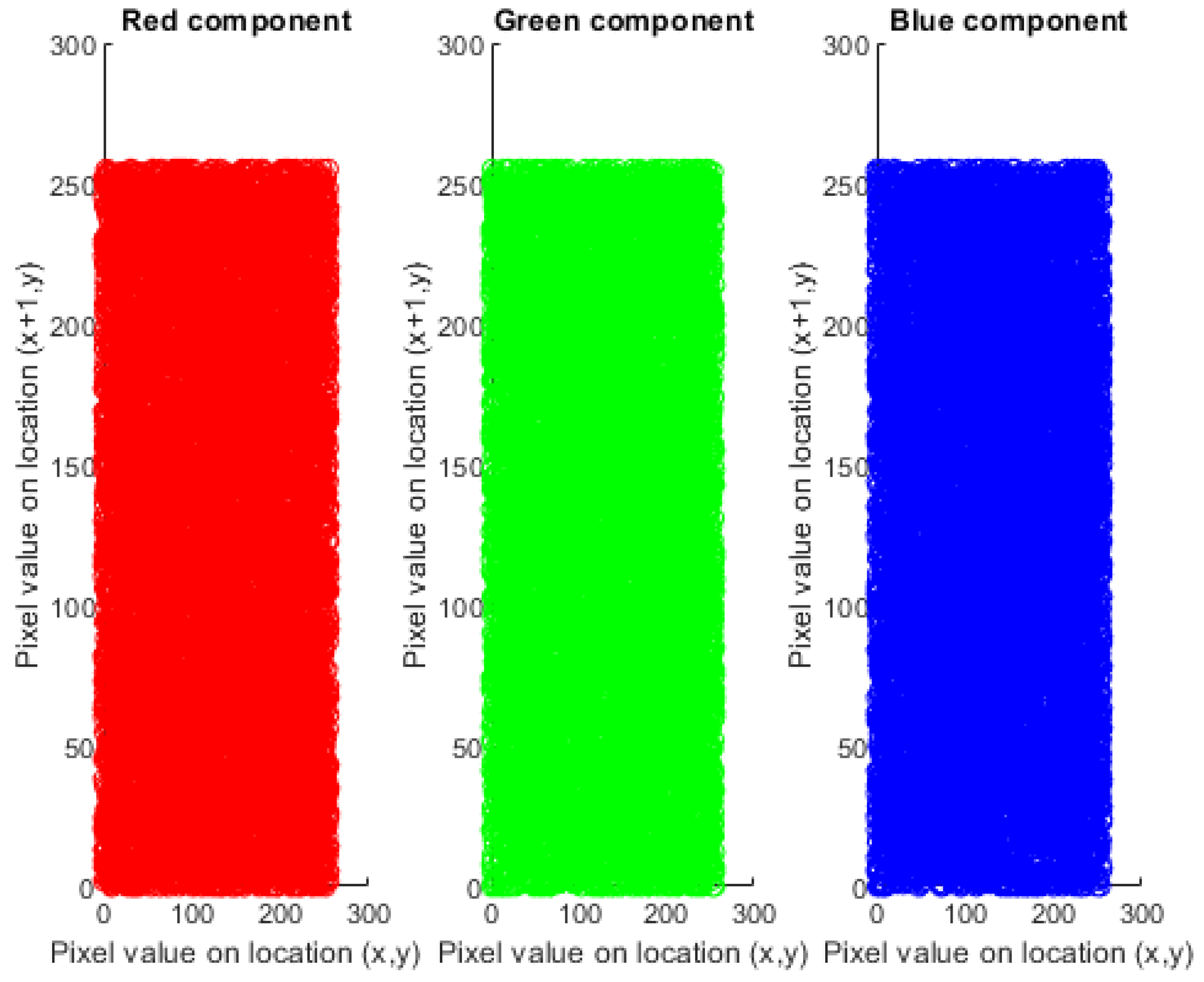
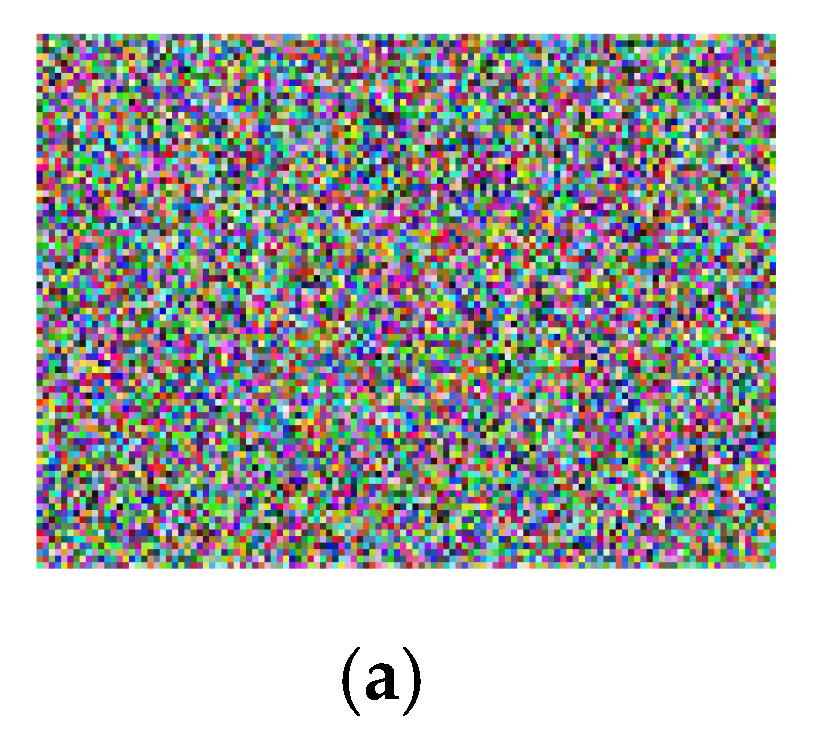
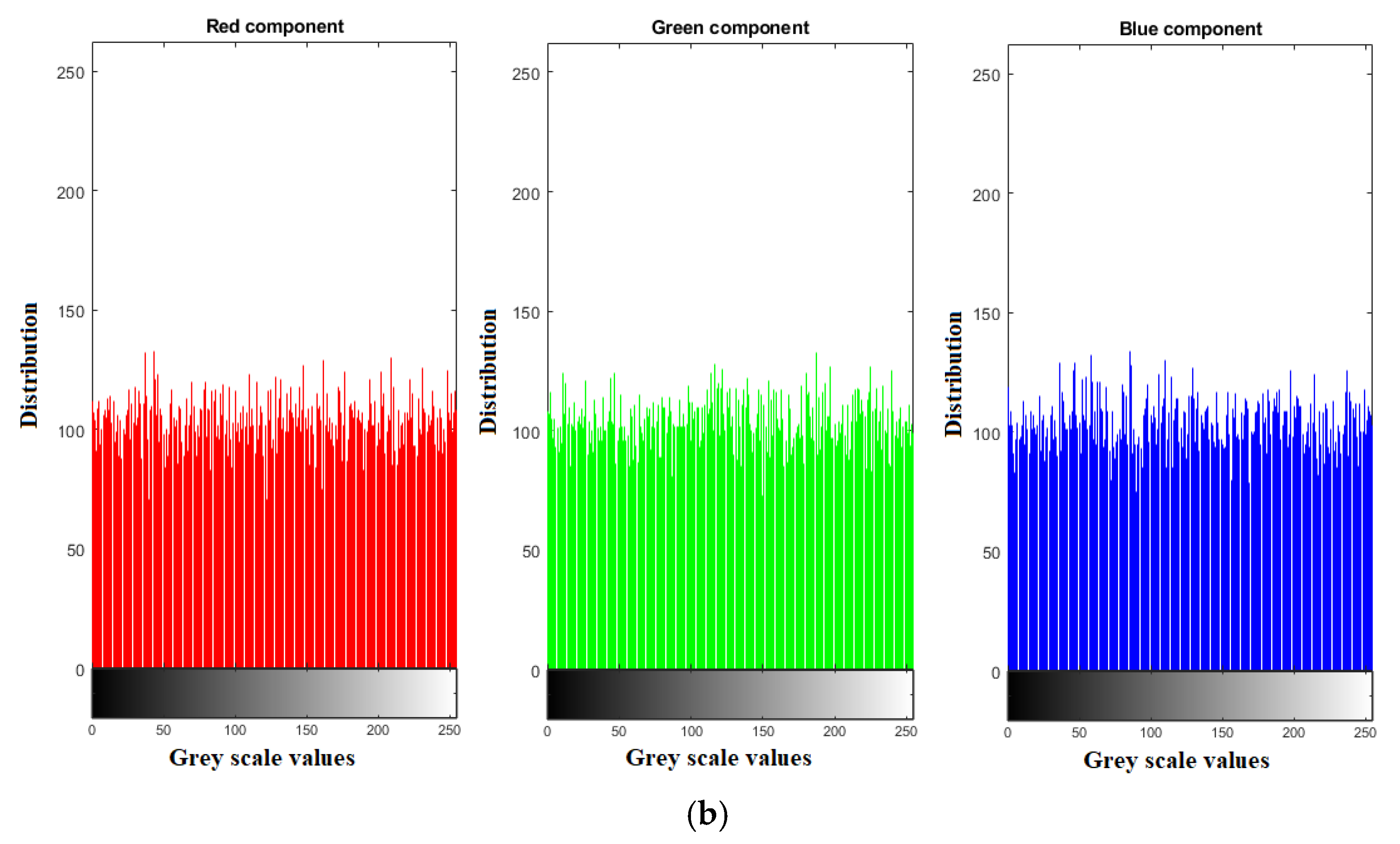

| Image | [12] | [13] | Proposed |
| Lena 256 | 982.5703 | 1071.0 | 980.50 |
| Image | Ref. [12] | Ref. [13] | Proposed | Testing Results | |
| 293.2478 | = 310.457 | ||||
| Lena 256 | 245.6426 | 267.7480 | 255.79 | pass | pass |
| Direction\Color | Red | Green | Blue | |||
|---|---|---|---|---|---|---|
| Original | Cipher | Original | Cipher | Original | Cipher | |
| Horizontal | 0.9794 | 0.0004 | 0.9806 | −0.0013 | 0.9604 | 0.0073 |
| Vertical | 0.9574 | −0.0028 | 0.9593 | −0.0062 | 0.9237 | −0.0014 |
| Diagonal | 0.9363 | −0.0048 | 0.9400 | −0.0002 | 0.8898 | 0.0064 |
| Image Encryption Scheme | MSE |
|---|---|
| Ref. [12] | 7762.6 |
| Ref. [13] | 7764.3 |
| Proposed Scheme | 8783.6 |
| Directions\Colors | Red | Green | Blue |
|---|---|---|---|
| Horizontal | 0.0091 | −0.0051 | 0.0095 |
| Vertical | 0.0078 | −0.0047 | 0.0093 |
| Diagonal | 0.0091 | 0.0152 | −0.0056 |
Publisher’s Note: MDPI stays neutral with regard to jurisdictional claims in published maps and institutional affiliations. |
© 2022 by the authors. Licensee MDPI, Basel, Switzerland. This article is an open access article distributed under the terms and conditions of the Creative Commons Attribution (CC BY) license (https://creativecommons.org/licenses/by/4.0/).
Share and Cite
Kanwal, S.; Inam, S.; Othman, M.T.B.; Waqar, A.; Ibrahim, M.; Nawaz, F.; Nawaz, Z.; Hamam, H. An Effective Color Image Encryption Based on Henon Map, Tent Chaotic Map, and Orthogonal Matrices. Sensors 2022, 22, 4359. https://doi.org/10.3390/s22124359
Kanwal S, Inam S, Othman MTB, Waqar A, Ibrahim M, Nawaz F, Nawaz Z, Hamam H. An Effective Color Image Encryption Based on Henon Map, Tent Chaotic Map, and Orthogonal Matrices. Sensors. 2022; 22(12):4359. https://doi.org/10.3390/s22124359
Chicago/Turabian StyleKanwal, Shamsa, Saba Inam, Mohamed Tahar Ben Othman, Ayesha Waqar, Muhammad Ibrahim, Fariha Nawaz, Zainab Nawaz, and Habib Hamam. 2022. "An Effective Color Image Encryption Based on Henon Map, Tent Chaotic Map, and Orthogonal Matrices" Sensors 22, no. 12: 4359. https://doi.org/10.3390/s22124359
APA StyleKanwal, S., Inam, S., Othman, M. T. B., Waqar, A., Ibrahim, M., Nawaz, F., Nawaz, Z., & Hamam, H. (2022). An Effective Color Image Encryption Based on Henon Map, Tent Chaotic Map, and Orthogonal Matrices. Sensors, 22(12), 4359. https://doi.org/10.3390/s22124359








